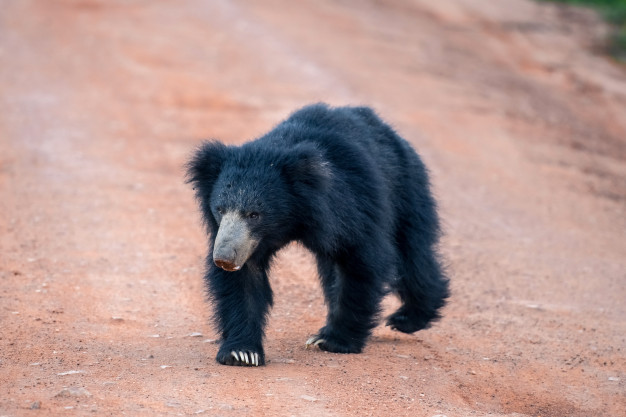Tadoba, the gift of wildlife that keeps on giving. We have elaborated in the past about how Tadoba is the quintessential land of tigers in the south. Nearly 140 tigers roam about freely in Tadoba thanks to state and central government conservation efforts and the efforts of the local communities in conserving this realm.
But there is more to a forest than one inhabitant. Indeed, Tadoba provides a home to nearly 50 species of small and large mammals, 40 species of reptiles, and over 300 species of birds. A single walk around our resort in Tadoba or an evening wildlife safari in Tadoba reveals the nature of these central Indian forests.
In today’s blog, we’d like to showcase some of the more elusive wildlife of Tadoba. While you may not be able to spot all of them on a wildlife safari in Tadoba, one can certainly hope for these shy citizens to grace us with their presence!
Striped Hyena:
If you thought India was devoid of hyenas, the Striped Hyena should dispel any doubt of the sort. These lanky scavengers are certainly a part of Tadoba’s landscape. They seldom make their presence known to the other residents of Tadoba’s forests but prefer to stick to themselves. But are they really there? Most definitely!

Image Credits: Res Cloudinary
Hyenas are members of the canine family. These animals may have a reputation for being lanky and cowardly due to portrayal in popular culture, but the truth is that the Hyena is an extremely intelligent being with complex social structures and extremely ambivalent behavior. Hyenas are family animals and also monogamous, with couples mating for life and taking care of the cubs in turn, together.
Being scavengers they feed primarily on carrion and the leftover scraps of other predators like tigers and leopards. Occasionally they will also choose to kill since they are equipped with sharp canines and quick reflexes to take down prey.
These magnificent animals are sadly endangered and are extremely elusive. But there’s a chance you might just see one on a wildlife safari in Tadoba, especially since our resort in Tadoba is located in the isolated Zari buffer zone!
Civets:
Highly coveted nocturnal animals, civets are even more elusive on a wildlife safari in Tadoba. The Small Indian Civet is particularly hard to find despite being classified as a species of least concern in IUCN records. You may have heard of the Indian Civet by another name, the toddy cat! This is because civets love drinking the fermented sap of palm trees and fruits and end up getting quite drunk by the end of the night!

Image Credits: Wikipedia
There are several species of civets in India with the Small Civet and the Palm Civet being the most common. Apart from getting drunk on toddy, civets feed on small mammals like rodents, lizards, and insects.
Civets might not look like it but they are related to the feline family! They too are nocturnal by nature and usually only show up in camera traps. But a night walk around our resort in Tadoba may reveal a lanky form slowly crossing the pathways in search of a palm tree…
Python:
The legend of Kaa, the mighty ally of Mowgli through his various adventures in the jungles of central India are definitely inspired by this beautiful reptile. The Rock Python is one of India’s longest and heaviest snakes. They can grow up to 11 ft in length and weigh up to 50 kilograms. They hide among rock outcrops or thick scrub jungle and since they are cold-blooded, prefer to come out during balmy evenings or early mornings in the case of summer.

Image Credits: Rahulalvares
Pythons are predators and are non-venomous; they take down their prey through a method known as constriction. With their powerful muscles, they trap prey in several coils and crush the unfortunate meal into oblivion. Like most pythons, they subsist on large mammals and birds.
You may just find the python, having swallowed dinner, lazing across a jeep trail on a wildlife safari in Tadoba!
Sloth Bear:
Another popular inhabitant of Kipling’s world, sloth bears are relatively more common than the other animals in this list. However, they are definitely easy to spot at first since they too are somewhat nocturnal and tend to shy away from human presence.

Image Credit:
Sloth Bears are known as the clowns of the Indian jungle. They are clumsy ursine animals with extra long and sharp claws that are perfect for probing and tearing termite hills apart, the home of their favorite meal. The bears are easily identified by the half-moon marking on their chest, a feature that develops as the young one’s age.
Sloth bears are omnivorous. They prefer insects but will also feast on fruits and sometimes even carrion from the jungle. They are particularly fond of mahua flowers that abound in Tadoba. Like their feline friends the civets, sloth bears to get drunk by eating mahua flowers and then letting the flowers ferment in their stomach!
Sadly the hunting and pet trade greatly impacted the Sloth Bear population in Tadoba and they are listed as vulnerable. But there’s every chance of sighting one during a wildlife safari in Tadoba!



